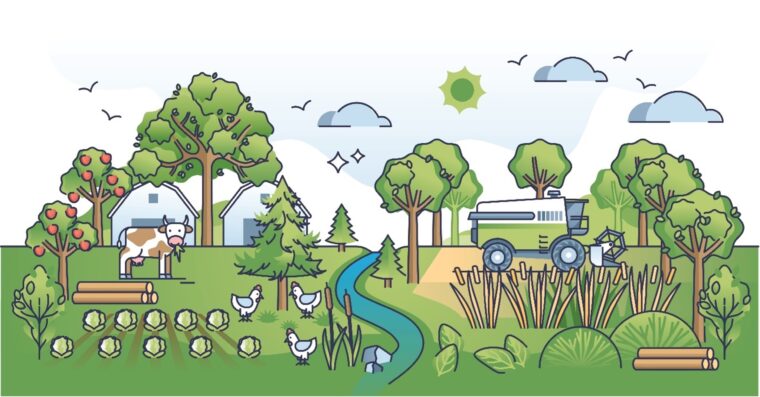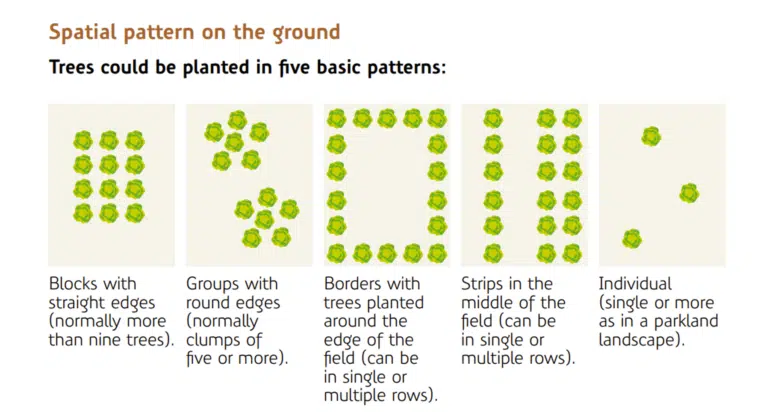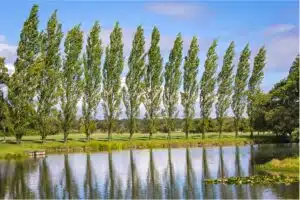Why integrate Biomass Crops into Agroforestry Systems?
Key messages:
- One promising dimension in agroforestry that is yet to realise its full potential is the integration of biomass crops.
- The deliberate incorporation of biomass crops into agroforestry systems can deliver a wide range of environmental benefits including improving soil health, carbon sequestration, enhancing biodiversity, and improving water quality.
- There is the need for policies and funding provisions to support integration of biomass crops in agroforestry systems.
Introduction
The UK government has made a commitment to achieve net-zero greenhouse gas emissions by 2050. As part of a comprehensive strategy addressing the effects of climate change, tree planting is a key component. The UK government has outlined an ambitious 25-year plan to improve the environment. This aims for a 12% tree cover by 2060, which will involve the planting of 180,000 hectares of trees by the end of 2042. In Wales, farmers are expected to allocate at least 10% of their land to tree cover in return for payments from the (currently delayed) Sustainable Farming Scheme (SFS). The Scottish government has similarly set targets to achieve a 21% forest and woodland cover by 2032, with a strong desire for greater integration of land use practices. Northern Ireland’s forest for our future programme aims to plant 9,000 hectares of new woodland (18 million trees) by 2030. To reach these goals, agroforestry can play a key role. To reach these goals, agroforestry will play a key role. Agroforestry is a land management approach that combines trees and shrubs with crop and livestock farming systems.
One promising dimension in agroforestry that is yet to realise its full potential is the integration of biomass crops (such as willow, poplar, alder, and black locust). When incorporated into agroforestry systems, biomass crops contribute in various ways, including, support for pollinator populations, biodiversity enhancement, flood risk reduction, minimized runoff and soil erosion, improved water quality, increased soil carbon sequestration, improved soil health and climate change mitigation. Moreover, they offer biomass for use as timber, wood fuel, bedding, and fodder. Despite these substantial benefits, the integration of biomass crops into agroforestry remains underexplored, with limited available information. This article focuses on the benefits of deliberate integration of biomass crops into agroforestry system.
Understanding Agroforestry Systems
Agroforestry is a deliberate practice that involves integrating woody vegetation, such as trees and shrubs, with agricultural and animal production systems to benefit from the resulting ecological and economic interactions. This can involve integrating livestock and crops into tree-only systems, as well as incorporating trees into farming systems that have crop, livestock, and mixed farms. There are five distinct types of agroforestry,including;
- Silvopastoral agroforestry, which combines trees with livestock.
- Silvoarable agroforestry, the combination of trees and crops.
- Hedgerows, shelterbelts, and riparian buffer strips, which entail growing trees between parcels of land.
- Forest farming, where crops are cultivated within a forest environment.
- Home gardens, characterized by the combination of trees and food production in proximity to households.
The tree component of agroforestry can be from a diverse range of tree and shrub species, including biomass tree crops (both short rotation forestry (SRF) and short rotation coppice (SRC)) integrated into existing landscapes. For instance, in silvoarable agroforestry, one might find combinations of poplar trees with oilseed rape or cherry with willow SRC. Silvopastoral agroforestry reduce heat stress for livestock,enhance their well-being and productivity, and provide fodder. Hedgerows, shelterbelts and riparian buffer strips are the most visible and recognisable forms of agroforestry in the UK. Only 3% of the UK farmed area practises agroforestry.
The establishment of agroforestry systems requires careful planning and well-designed layouts. Depending on the tree type, the agricultural components and their spatial and temporal arrangement, competition for light, nutrients, and water, can intensify, potentially leading to yield reduction. However, with appropriate planning and precise spatial arrangements, the advantages of agroforestry can surpass those of monocropping systems.
The format by which agroforestry is implemented can vary widely, from uniform rows of arable crops and forestry, to expanding the width and amounts of hedgerows on pastureland. The agroforestry handbookprovides practical guidelines and design considerations (Fig.1) for establishing agroforestry systems.
Why integrate biomass crops into agroforestry systems?
Strategic planting of dedicated biomass tree crops in agroforestry systems can increase landscape heterogeneity and enhance ecosystem function. There are several benefits of incorporating biomass crops into agroforestry systems:
Carbon Sequestration and tackling climate change
Incorporating trees or shrubs into farmlands or pastures has proven to be a highly effective strategy for enhancing carbon sequestration compared to monoculture fields of crops or pastures. The integration of biomass crops within agroforestry systems serves as an effective mechanism for capturing and storing carbon from the atmosphere through the process of photosynthesis. These biomass crops play a substantial role in reducing atmospheric carbon dioxide concentrations by accumulating relatively large quantities of carbon in above and below-ground biomass and in the soil. These crops exhibit the potential to sequester significant volumes of carbon dioxide that they absorb during their growth, storing this carbon within the soil. Additionally, the fallen leaves and branches from these biomass crops contribute organic matter to the soil, further enhancing long-term carbon storage.
The root structure of biomass crops continuously expands throughout their life cycle, storing and transferring carbon to the soil. For instance, a study conducted in Southern England illustrated that SRC willow plantations had reduced soil respiration (912 ± 42 g C m-2 yr-1 ) and acted as a net carbon sink of 221 ± 66 g C m-2 yr-1). Another study showed that when biomass crops are established in areas with low carbon content (less than 60–70 Mg C/ha at 0–30 cm depth), they have the potential to increase soil carbon stocks. Additionally, planting biomass crops in degraded land can sequester carbon ranging from 0.6 to 3.0 Mg C ha-1 yr-1. The considerable benefits of biomass crops in sequestering carbon not only underscore their significance in mitigating climate change and reducing greenhouse gas emissions but also position them as vital crops for long-term carbon storage. The carbon stored has potential to then be sold in carbon credit markets.
Biodiversity enrichment
Biomass crops are beneficial for biodiversity compared with conventional cultivated areas of arable food crops. Several factors contribute to their positive impact, including longer rotation periods, low fertiliser and pesticide requirements, enhanced soil protection, greater spatial diversity, reduced disturbances during the growth phase, and the option to conduct harvesting during the winter or after the bird breeding season, minimising disruptions. Integrating biomass crops into agroforestry systems creates a diverse range of habitats and resources that attract various wildlife species. This combination of factors establishes an environment conducive to the survival and proliferation of diverse plant and animal species.
Biomass crops, such as willow and poplar, establish dense and varied stands that offer various niches and microhabitats. For instance, SRC willow contributes significantly to plant diversity when integrated into existing landscapes and agricultural systems. SRC willow plantations exhibit higher plant species richnessand increased weed cover compared to neighbouring arable agricultural lands. For example, a studyfound 27% greater plant species richness (133 flora species) and greater weed cover on SRC willow plantation when compared to the neighbouring arable agricultural land. Furthermore, a study into silvopastoral agroforestry, with 35-year-old poplar stands within grazed permanent pastures, found this interaction to offer a viable way of increasing the diversity of invertebrates, arthropods, and birds in grassland systems. The increased biodiversity within agroforestry systems with biomass crops contributes significantly to natural pest control. These ecosystems attract beneficial insects, such as ladybugs and parasitoid wasps, helping regulate pest populations. Consequently, this can reduce the need for chemical pesticides and promote more ecologically sustainable pest management practices.
Biomass crops, especially when integrated into agroforestry systems, provide valuable opportunities for fostering and preserving biodiversity, with positive effects often observed at the field scale. However, it is important to note that the impact on biodiversity within biomass plantations can vary significantly based on factors like plantation management, age, size, and heterogeneity.
Water and air quality improvement
Agroforestry systems with biomass crops can help regulate water flow, reducing surface runoff and the associated risks of flooding and water pollution. Biomass agroforestry systems, such as riparian buffersare recommended as a solution to combat nonpoint source pollution from agricultural land.
In areas where agricultural land is more intensively managed, nitrate and phosphorous leaching and run-off are identified as the main source of pollution resulting in eutrophication of lakes and waterways. Biomass crops can act as biological filters that take up and utilise nutrients before they enter watercourses. The crops have deep root systems that serve as safety nets, absorbing nutrients that have leached below the rooting zones of most arable crops.
For instance, a study showed increased nutrient removal (between 30-99% of nitrate and 20-100% of phosphorous) when biomass trees were incorporated into agricultural fields. Biomass crops such as willow SRC have been shown to be particularly effective for shown to be particularly effective for permanent nutrient removal of 55 kg PO43−eq ha-1 yr-1 based on field trials conducted in Northern Ireland.
Also, biomass crops (depending on their height and location within the landscape) can act as windbreaks and shelterbelts as well as protecting buildings and roads from snow drifts, and noise pollution. A mixture of both SRC and SRF in agroforestry system can offer the benefit of improving air and water quality.
Reduce soil erosion and improve soil health
The integration of biomass crops into agroforestry systems provides significant benefits for soil health and erosion control. Biomass crops have extensive root systems that help bind soil particles and prevent them from being washed away during heavy rainfall or strong winds. Biomass crop root systems reduce erosionby enhancing water infiltration, minimizing impacts by water droplets, intercepting rain and snow and stabilizing soil through their roots and leaf litter. Biomass crops have the potential to improve the soil’s physical, chemical, and biological properties by adding substantial amounts of above and below-ground organic matter, as well as the release and recycling of nutrients when integrated into agroforestry systems.
For instance, black locust roots form a symbiotic association with nitrogen-fixing bacteria, which form nodules on the roots and convert atmospheric nitrogen into ammonium in the soil, thereby enhancing soil fertility. When these crops are planted on marginal lands, they have the potential to rehabilitate and improve soil conditions. Black locust has been used successfully in mine reclamation in Germany and in reclaiming degraded lands in Romania. Studies have shown willow and poplar tree potential for use in the phytoremediation of soil contaminated with heavy metals.
Current UK policy
Biomass crops and SRF (<8-year rotation) are ineligible under current rules for woodland grants and incentives. There is therefore a need to develop policies that facilitate the integration of these crops into farming systems, acknowledging the environmental benefits provided by these crops, including improving soil health, carbon sequestration, enhancing biodiversity, and improving water and air quality. To encourage planting of these biomass crops on farms, grant options may be included in support schemes that farmers are already familiar with, such as the Environmental Land Management (ELM) Scheme in England, AgriEnvironment Climate Scheme (AECS) in Scotland, Sustainable Farming Scheme (SFS) in Wales, Small Woodland Grant scheme or the Forest Expansion Scheme in Northern Ireland, and the woodland grants and incentives available for establishing and maintaining woodland for nature recovery.
Further information:
Related Biomass Connect Articles:
- How does Short Rotation Coppice (SRC) willow affect biodiversity?
- What effect does planting biomass crops have on soil carbon?
- Biomass Buffer Strips – using biomass crops in multipurpose land management
Other resources:
- The Agroforestry Handbook
- Forestry Commission – Grant funding for woodland
- Funding for landowners – Nature based solutions to reduce flood risk
- Natural Flood Management Handbook – A practical guide for farmers.






